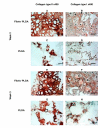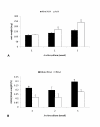Fibrin and poly(lactic-co-glycolic acid) hybrid scaffold promotes early chondrogenesis of articular chondrocytes: an in vitro study
- PMID: 18435862
- PMCID: PMC2405772
- DOI: 10.1186/1749-799X-3-17
Fibrin and poly(lactic-co-glycolic acid) hybrid scaffold promotes early chondrogenesis of articular chondrocytes: an in vitro study
Abstract
Background: Synthetic- and naturally derived- biodegradable polymers have been widely used to construct scaffolds for cartilage tissue engineering. Poly(lactic-co-glycolic acid) (PLGA) are bioresorbable and biocompatible, rendering them as a promising tool for clinical application. To minimize cells lost during the seeding procedure, we used the natural polymer fibrin to immobilize cells and to provide homogenous cells distribution in PLGA scaffolds. We evaluated in vitro chondrogenesis of rabbit articular chondrocytes in PLGA scaffolds using fibrin as cell transplantation matrix.
Methods: PLGA scaffolds were soaked in chondrocytes-fibrin suspension (1 x 10(6) cells/scaffold) and polymerized by dropping thrombin-calcium chloride (CaCl2) solution. PLGA-seeded chondrocytes was used as control. All constructs were cultured for a maximum of 21 days. Cell proliferation activity was measured at 1, 3, 7, 14 and 21 days in vitro using 3-(4,5-dimethylthiazole-2-yl)-2-, 5-diphenyltetrazolium-bromide (MTT) assay. Morphological observation, histology, immunohistochemistry (IHC), gene expression and sulphated-glycosaminoglycan (sGAG) analyses were performed at each time point of 1, 2 and 3 weeks to elucidate in vitro cartilage development and deposition of cartilage-specific extracellular matrix (ECM).
Results: Cell proliferation activity was gradually increased from day-1 until day-14 and declined by day-21. A significant cartilaginous tissue formation was detected as early as 2-week in fibrin/PLGA hybrid construct as confirmed by the presence of cartilage-isolated cells and lacunae embedded within basophilic ECM. Cartilage formation was remarkably evidenced after 3 weeks. Presence of cartilage-specific proteoglycan and glycosaminoglycan (GAG) in fibrin/PLGA hybrid constructs were confirmed by positive Safranin O and Alcian Blue staining. Collagen type II exhibited intense immunopositivity at the pericellular matrix. Chondrogenic properties were further demonstrated by the expression of genes encoded for cartilage-specific markers, collagen type II and aggrecan core protein. Interestingly, suppression of cartilage dedifferentiation marker; collagen type I was observed after 2 and 3 weeks of in vitro culture. The sulphated-glycosaminoglycan (sGAG) production in fibrin/PLGA was significantly higher than in PLGA.
Conclusion: Fibrin/PLGA promotes early in vitro chondrogenesis of rabbit articular chondrocytes. This study suggests that fibrin/PLGA may serve as a potential cell delivery vehicle and a structural basis for in vitro tissue-engineered articular cartilage.
Figures






Similar articles
-
The use of fibrin and poly(lactic-co-glycolic acid) hybrid scaffold for articular cartilage tissue engineering: an in vivo analysis.Eur Cell Mater. 2008 Feb 21;15:41-52. doi: 10.22203/ecm.v015a04. Eur Cell Mater. 2008. PMID: 18288632
-
Fibrin promotes proliferation and matrix production of intervertebral disc cells cultured in three-dimensional poly(lactic-co-glycolic acid) scaffold.J Biomater Sci Polym Ed. 2008;19(9):1219-37. doi: 10.1163/156856208785540163. J Biomater Sci Polym Ed. 2008. PMID: 18727862
-
The potential of 3-dimensional construct engineered from poly(lactic-co-glycolic acid)/fibrin hybrid scaffold seeded with bone marrow mesenchymal stem cells for in vitro cartilage tissue engineering.Tissue Cell. 2015 Aug;47(4):420-30. doi: 10.1016/j.tice.2015.06.001. Epub 2015 Jun 10. Tissue Cell. 2015. PMID: 26100682
-
Chondrogenic differentiation of mesenchymal stem cells and its clinical applications.Yonsei Med J. 2004 Jun 30;45 Suppl:41-7. doi: 10.3349/ymj.2004.45.Suppl.41. Yonsei Med J. 2004. PMID: 15250049 Review.
-
Use of mesenchymal stem cells seeded on the scaffold in articular cartilage repair.Inflamm Regen. 2018 Mar 12;38:4. doi: 10.1186/s41232-018-0061-1. eCollection 2018. Inflamm Regen. 2018. PMID: 29560045 Free PMC article. Review.
Cited by
-
Fibrinogen and fibrin based micro and nano scaffolds incorporated with drugs, proteins, cells and genes for therapeutic biomedical applications.Int J Nanomedicine. 2013;8:3641-62. doi: 10.2147/IJN.S43945. Epub 2013 Sep 25. Int J Nanomedicine. 2013. PMID: 24106425 Free PMC article. Review.
-
The pilot study of fibrin with temporomandibular joint derived synovial stem cells in repairing TMJ disc perforation.Biomed Res Int. 2014;2014:454021. doi: 10.1155/2014/454021. Epub 2014 Apr 15. Biomed Res Int. 2014. PMID: 24822210 Free PMC article.
-
Development of a cartilage composite utilizing porous tantalum, fibrin, and rabbit chondrocytes for treatment of cartilage defect.J Orthop Surg Res. 2015 Feb 7;10:27. doi: 10.1186/s13018-015-0166-z. J Orthop Surg Res. 2015. PMID: 25889942 Free PMC article.
-
Sciatic nerve repair with tissue engineered nerve: Olfactory ensheathing cells seeded poly(lactic-co-glygolic acid) conduit in an animal model.Indian J Orthop. 2013 Nov;47(6):547-52. doi: 10.4103/0019-5413.121572. Indian J Orthop. 2013. PMID: 24379458 Free PMC article.
-
Challenges and strategies in the repair of ruptured annulus fibrosus.Eur Cell Mater. 2013 Jan 2;25:1-21. doi: 10.22203/ecm.v025a01. Eur Cell Mater. 2013. PMID: 23283636 Free PMC article. Review.
References
-
- Ito Y, Ochi M, Adachi N, Sugawara K, Yanada S, Ikada Y, Ronakorn P. Repair of osteochondral defect with tissue engineered chondral plug in rabbit model. Arthroscopy. 2005;21:1155–63. - PubMed
LinkOut - more resources
Full Text Sources
Other Literature Sources

